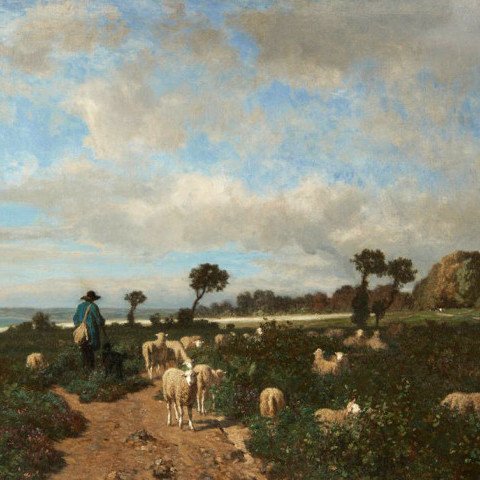Constant Troyon was born in 1810 in Sèvres, the son of a decorator of porcelain. He received his early training in this craft at the royal china works of Sèvres but at the same time followed his own interests by sketching out-of-doors in the vicinity of Meudon and Saint-Cloud. Like several of the other landscape painters of his generation who ultimately formed the group of Barbizon, he was essentially self-trained. His acquaintance with the painter Paul Huet (1803-1869), begun in about 1830, brought him under the influence of a current of naturalist landscape painting, of English origin, that had received a strong impulse in France from the exhibition of John Constable's Hay Wain (National Gallery, London) at the Paris Salon of 1824. About 1832, the painter Camille Roqueplan (1802-1855), met by chance in the park of Saint-Cloud, introduced him to Théodore Rousseau (1812-1867), Jules Dupré (1811-1889), and Narcisse Diaz de la Peña (1808-1876), who became particularly influential on his further development. He had his first public exhibitions at the Salons of the 1830s, traveled extensively in the French provinces, and, beginning in the early 1840s, worked frequently in the forest of Fontainebleau and in Brittany.
In 1842 he established himself in Paris. Specializing entirely in landscape painting throughout his early years, Troyon changed direction after a voyage to Holland in 1847 during which he came under the spell of the Dutch animal painters, particularly of Paulus Potter (I625-1654) and Aelbert Cuyp (1620-1691). Animal painting thereafter became his central interest; he adapted his landscapes to furnish the luminous and atmospheric settings by which he dramatized his compositions. Awarded first-class medals at the Salons of 1846 and 1848, elected to the Legion of Honor in 1849, Troyon became one of Europe's most prominent and highly rewarded painters, at a time when many of his friends at Barbizon were still struggling for recognition. His preference for unusually large formats, not unlike those of Constable's exhibition pieces, probably furthered his Salon successes, by giving his work a visibility and weight beyond that of ordinary landscape and genre painting, though sometimes at the expense of the freshness of his naturalist vision.
During the 1850s, Troyon frequently worked on the Norman coast, where, in 1854, he established himself in a house of his own at Villers-sur-Mer. Member of the jury of the Universal Exposition in 1855 and winner of a first-class medal at that prestigious occasion, his income enabled him to engage the architect Eugène-Emmanuel Viollet-le-Duc to build him a grand town residence with large studio. In 1859 he showed at the Salon for the last time. His health had meanwhile begun to fail. The paralytic symptoms of a venereal infection at first slowed, then put an end to his work. In the spring of 1864 he showed symptoms of persecution mania and suffered fits of rage that required his commitment to an asylum. Released after eight months of confinement, he died in Paris on 20 March 1865. He was considered at that time a painter in the very first rank of modern French artists, but by the end of the century his reputation was in decline, owing largely to the waning of public interest in the rural animal genres that had been his renowned speciality.
Selected Museum Collections:
Paris, Musée d’Orsay, Musée du Louvre; New York, Metropolitan Museum of Art, Frick Collection, Brooklyn Museum; Boston, Museum of Fine Arts; Buenos Aires, Museo Nacional de Bellas Artes; Cambridge, Harvard University Art Museums; Art Institute of Chicago; Detroit Institute of Arts; Los Angeles County Museum of Art; Pasadena, CA, Norton Simon Museum; Philadelphia Museum of Art; Pittsburgh, Carnegie Museum of Art; Fine Arts Museums of San Francisco; Hermitage Museum, Saint Petersburg; Taiwan, Chi-Mei Museum; Washington DC, National Gallery of Art; Williamstown, MA, Clark Art Museum
Source: www.nga.gov

